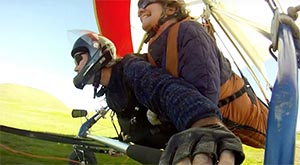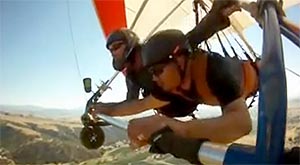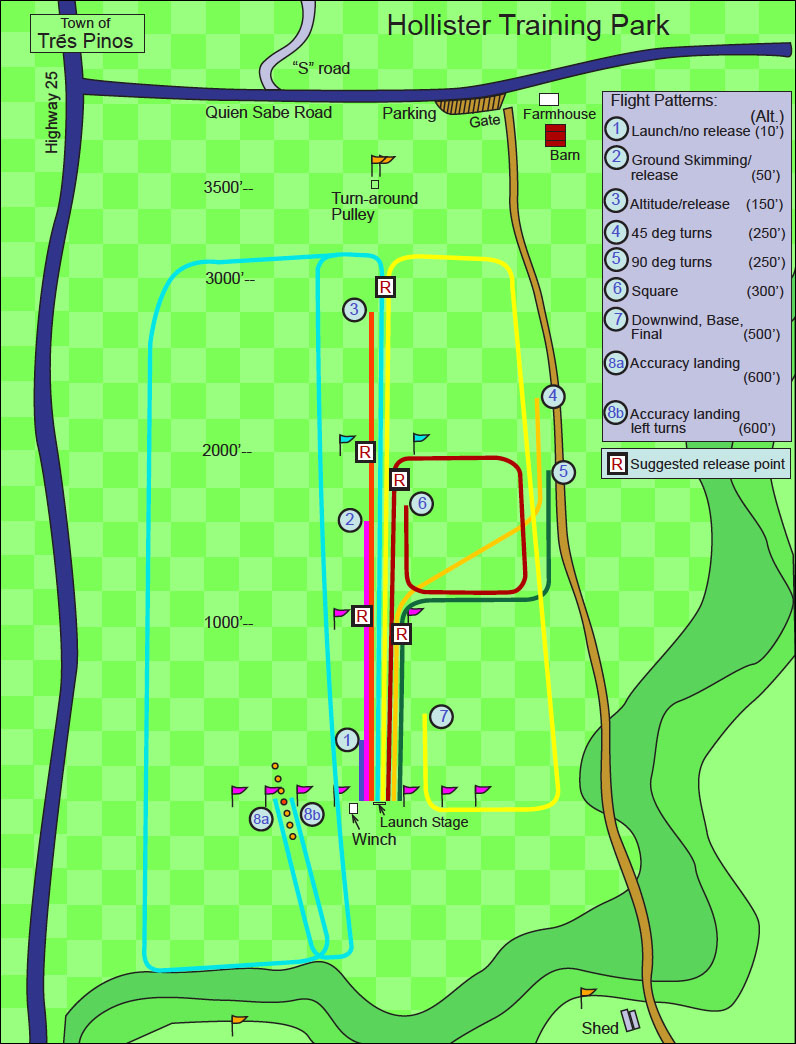
Our training site has practice hills that are a great way to start with a landing zone that is a mile long and a half mile wide. Over the years, we have taught at dozens of sites in the Bay Area, but Tres Pinos is by far the best place for teaching Hang Gliding. The hills are gentle and the training area has the most consistent, reliable winds anywhere in the Bay Area. With foot launched flight it is important to have the wind blow up the hill - the valley where our training site is located, funnels the wind straight in for the best possible training experience.
Book Now
Directions
The town of Tres Pinos is 5 miles past Hollister on Highway 25, turn left on Quien Sabe Road. The first gate on the right is where you’ll park and meet your instructor. (Only instructor vehicles are allowed beyond the gate.)
Directions
Videos
Click on picture to view corresponding video
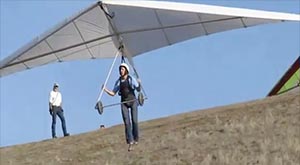
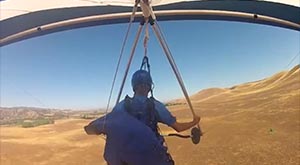

Photo Sphere
Places to Stay
- Paicines Ranch - Airbnb lodgings
- Joshua Inn Bed and Breakfast
- RidgeMark Golf and Country Club Lodge
- Best Western San Benito Inn
- Hollister Inn
- Wiebe Motel
- The Cinderella Motel
Nearby Wineries
Other Nearby Attractions
Mission Soaring Center has a unique towing system which provides students with the opportunity to experience high altitude flights and to work through their progression of skills to gain their advanced Hang Gliding ratings.
How it works: For students who have earned their first rating and for advanced hang glider pilots, we can tow them into the air using a Pitman Hydraulic Winch System. Unlike other tow systems, the student pilot and the winch operator start out next to each other. As the pilot is pulled into the air, the winch operator can adjust the tension or even stop the tow if the pilot goes off course. Our tow system is considered to be the safest in the industry.
How high: To be introduced to towing, beginners are towed at the same level above the ground that they’ve been flying on the practice hills. After showing tow-competency, the next step is to go to progressively higher altitudes and release from the tow line to fly free. At that point, standard tows can take pilots up to a 1000 feet. More advanced pilots can use a tow process known as step towing to reach 2000+ feet.
Then what: As pilots progress, they can learn to fly in thermals (rising bubbles of air) and stay aloft for longer and higher flights. In fact, students have learned to work the lift to stay up for over a half hour with a gain of 1000 feet above their release point. A number of advanced pilots have been towed up to then fly ‘cross country’. At Tres Pinos, the distance record is a cross country flight to the south just shy of 30 miles.
- For students who have received their H1 Certification and for experienced hang glider pilots
- Tow up to 1,000 feet at first and up to 2,000 for experienced pilots
- Cost - $35/tow
The image below shows the progression of flight patterns that a pilot can fly while working on his or her skills.

(for printing use the pdf of Tow patterns)
The USHPA (United States Hang Gliding and Paragliding Association) has a defined a Pilot Proficiency System for ensuring pilot skills match the requirements to fly a given flying site. Pilots are assigned a pilot rating 1 - 4 (Beginner, Novice, Intermediate and Advanced).
With Mission Soaring Center, your first day of flying is part of the progression of getting tasks signed off by USHPA Certified Instructors and working towards attaining your skill-level ratings.
H1 - Beginner Hang Gliding Pilot: Has the knowledge to set up and pre-flight the glider, as well as the basic skills necessary to have consistent, smooth take-offs and soft landings, fly in a straight line and land where the student and the instructor designate. Also, the student must take a written test to show an understanding of weather conditions and the knowledge necessary for flying at different flying sites. With a H1, the pilot may fly and practice without direct supervision within certain operating limitations.
H2 - Novice Hang Glider Pilot: In addition to H1 skills, has the knowledge and basic skills necessary to make coordinated 90° turns, to circle in thermal conditions to gain altitude, and show accuracy landings by landing within a specified area. The student must take a written test to show knowledge of the effect that wind conditions and environmental factors have on the ability to pilot a hang glider. With a H2, the pilot may fly at a number of hills in the Bay Area and can participate in many of the hang gliding safaris that are offered through Mission Soaring Center.
H3 - Intermediate Hang Glider Pilot: In addition to H1 and H2 skills, has the knowledge and skills necessary to link 180° turns, perform smooth 360° turns in both directions and recover from controlled stall conditions. The written test will include questions that cover many of the FAA rules, the specific impact of radical weather conditions, and questions requiring judgment and experience in varied flying situations. In addition to demonstrating flying skills and taking the written test, the pilot must have logged at least 10 hours of air time in order to qualify for a H3 rating. With a H3, the pilot may fly at most flying sites in the Bay Area and the Sierra Mountains.
H4 – Advanced Hang Glider Pilot: In addition to H1 - H3 skills, has the knowledge and skills necessary to fly at any flying site and show an ability for accuracy landing in a tight, technical landing zone. The written test will include specific questions for skills gained through hours of flying in various challenging conditions and cross-country flights. In addition, the pilot must have logged 75 hours of air time to qualify for a H4 rating. With a H4, the pilot may fly at all USHPA rated flying sites including Mount Diablo, Mission Peak and Yosemite.
Come join us for a tandem tow and enjoy a new high perspective from the air. This is a great way to experience hang gliding. First, a certified tandem flight instructor will talk to you about what to expect of the flight to come. The two of you are then hooked in, side-by-side, to a tandem hang glider.
The hang glider is set up to safely take off and land on wheels so that no running is required. After you and the hang glider are hooked to a towline, the fun begins. You experience the glider being towed: rolling, rolling, lifting off and you take to the air with the instructor at the controls. After a few minutes of being attached to the tow line you will be well over 1000 feet above the ground and it’s time to be set free from tow. You are now gliding freely around the sky while taking in the awesome view from above. About this time, your instructor will let you try your hand at at flying the glider.
As you approach the ground, your instructor eases the hang glider back onto the ground and rolls to a stop (similar to the landing of a conventional aircraft). The typical flight duration is around 6 minutes or longer depending on conditions. People must be at least 18 years old to fly tandem at Tres Pinos. The weight limit is 200 lbs.
This is an experience you will never forget! This flight experience will help improve your flying dreams!
We can mount one of our cameras to the glider to take a video of you and your tandem flight high above the beautiful training area.
Videos
The Mission Soaring Training Program is a model for schools across the country. We are known for our well developed training program with an emphasis on the fun, intense and wonderfully empowering feeling of flight with a primary focus on safety. Owner Pat Denevan is a leader in the development of modern training standards, has been on the Board of the United States Hang Gliding Association (USHGA) and has been instrumental in developing their Instructor Certification Program. At Mission Soaring you will train with experienced, USHGA Certified Instructors. Our small classes provide plenty of personal attention - instruction is complete, flexible and tailored to each student from beginner through advanced skills.
Confirm Your Class is Taking Place
We live in California where we fly year-round because the weather is always perfect ... except, sometimes it's not. Advanced pilots, regular students, first timers, everyone - should call our Class Confirmation Message (408-262-1055) no more then 3hrs before the scheduled session to learn if the class is on or being cancelled due to adverse conditions. What may appear to be a beautiful day may infact be forcasted to not be for instruction and/or towing. Some days are clear and sunny but simply blowing from the wrong direction or too windy. Always call witihin 3 hours of your lesson to save from driving to our training site unnecesarilly.

